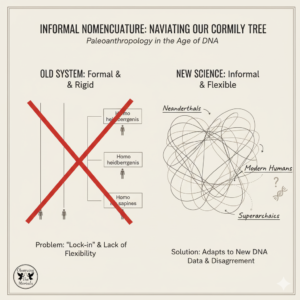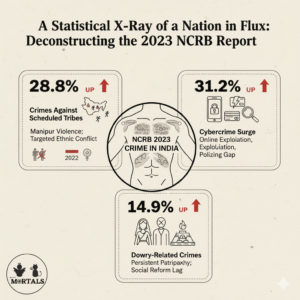In the heart of Jharkhand’s Kolhan region, a recent Adivasi protest against the district administration has brought a fascinating piece of living history into the national spotlight. The issue at hand is the Manki-Munda system, a traditional form of self-governance belonging to the Ho community. This is not merely a story about cultural preservation; it’s a complex narrative of a colonial-era administrative system, legally recognized even today, clashing directly with the authority of the modern Indian state. This case study explores a fundamental conflict: how does a 19th-century hereditary system of governance function within the framework of a 21st-century democracy?
The Information Box
Syllabus Connection:
- Paper 1: Chapter 4 (Political Anthropology), Chapter 4.3 (Legal Anthropology)
- Paper 2: Chapter 6.2 (Tribal Administration), Chapter 8 (Social Change among Tribes), Chapter 9.3 (Tribal Movements)
Key Concepts/Tags:
- Manki-Munda System, Ho Tribe, Wilkinson’s Rules, Legal Pluralism, Traditional Governance, Tribal Autonomy
The Setting: Who, What, Where?
This case study is centered on the Ho Adivasi community of the Kolhan region in West Singhbhum, Jharkhand. Their traditional social and political life is governed by the Manki-Munda system, a two-tier structure where a Munda is the hereditary head of a single village, and a Manki is the head of a cluster of villages (known as a patti). This system was formally codified by the British colonial administration through the Wilkinson’s Rules of 1833, a document that remains legally valid and is at the heart of the current conflict.
The Core Argument: Why This Study Matters
The recent protests highlight a deep-seated conflict between tradition and modernity, rooted in a unique colonial legacy. The core issue is the struggle for administrative control and the relevance of a traditional system in the modern era.
- A Colonial Legacy with Legal Teeth: After failing to suppress the powerful Ho rebellions of the 1820s, the British adopted a strategy of co-option. Thomas Wilkinson codified and empowered the existing Manki-Munda system, making them official agents for revenue collection and justice. This gave the system a unique, formal legal sanctity that many other tribal customs lack.
- Legal Pluralism in Action: The system’s continued legal validity, affirmed by the Patna High Court (2000) and the Jharkhand government (2021), creates a classic case of legal pluralism. Here, a colonial-era administrative structure directly coexists and competes for power with the modern democratic apparatus of the District Administration (Deputy Commissioner) and the Panchayati Raj system. This overlap is the primary source of the “turf war.”
- An Internal Crisis of Modernity: The system faces a critical internal challenge. Its hereditary nature is fundamentally at odds with modern democratic principles of election and representation. This creates a generational divide and a governance gap, as many who inherit these powerful positions are not formally educated, making it difficult for them to navigate the complexities of modern administration and development schemes.
The Anthropologist’s Gaze: A Critical Perspective
An anthropological analysis reveals deeper layers beyond the surface-level conflict.
- The “Invention of Tradition”: A critical perspective would argue that Wilkinson’s Rules did not just preserve the Manki-Munda system; they fundamentally transformed and “invented” it in a new form. By making the Manki and Munda accountable to the British Crown, their role shifted from being purely organic community leaders to also being agents of an external, colonial power. The current struggle, therefore, is to preserve a tradition that was itself shaped and codified by colonialism.
- Power, Not Just Culture: The conflict is as much about power and control over resources as it is about cultural preservation. The traditional leaders act as gatekeepers to the community. For instance, there are contemporary complaints and reports from the region of some Mundas preventing villagers from accessing government benefits or of non-tribals being appointed to these hereditary posts. Such issues highlight how traditional systems can, in some cases, become tools for elite capture and control rather than pure community welfare.
- Tradition as a Dynamic Process: The calls for reform from within the Ho community show that “tradition” is not a static relic. Culture is constantly adapting. The central anthropological question is not if the system should change, but how it can evolve to meet contemporary needs without sacrificing its core principles of community autonomy and cultural identity.
The Exam Angle: How to Use This in Your Mains Answer
- Types of Questions Where It Can Be Used:
- “Discuss the challenges faced by tribal self-governance systems in the face of the modern state.”
- “Legal pluralism in India often creates administrative conflict. Explain with ethnographic examples.”
- “Analyze the impact of British colonial policies on the administrative systems of tribal communities.”
- Model Integration:
- On Legal Pluralism: “A prime example of legal pluralism leading to administrative conflict is the Manki-Munda system in Jharkhand. Legally protected by the colonial-era Wilkinson’s Rules, this traditional governance structure often clashes with the authority of the modern district administration, creating a persistent turf war over jurisdiction.”
- On Tribal Administration: “The uniform application of the Panchayati Raj system faces challenges in areas with strong, pre-existing governance structures. The Ho tribe’s Manki-Munda system, for instance, is a legally recognized, hereditary system that operates parallel to, and often in contention with, elected local bodies, highlighting the need for a more nuanced approach to tribal administration.”
- On Colonial Impact: “The British policy of indirect rule has left a complex legacy, as seen with the Manki-Munda system of the Ho tribe. By codifying and formalizing this system, the British gave it legal durability but also integrated it into the colonial state, a structure that now complicates its relationship with the modern Indian democratic framework.”
Mentor’s Take
The Manki-Munda controversy is a microcosm of one of the greatest challenges in Indian tribal policy: how to balance the constitutional mandate to protect unique cultural and administrative traditions with the democratic imperative of modern, elected governance. It proves that the past is not dead; in places like Kolhan, it is a living, breathing part of the political present. The path forward is not about choosing tradition or modernity, but about finding a creative synthesis that empowers the community while upholding the principles of democratic accountability. This is where a sensitive, anthropologically-informed administration becomes crucial.




